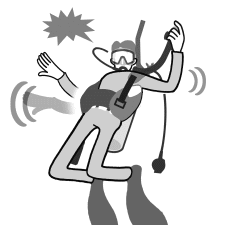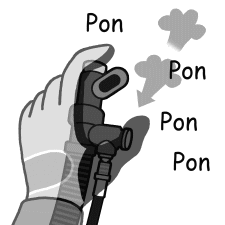
Boyancy specialty
Certification card
Buoyancy
Neutral buoyancy
Neutral buoyancy at surface
Change in buoyancy
Buoyancy control 1
Buoyancy control 2
Buoyancy control 3
Buoyancy control training 1
Buoyancy control training 2
Buoyancy control training 3
|

|
■Adjustment of buoyancy by BC
The only time to add air to the BC is when you are resting on the surface or when the buoyancy of the BC or suit decreases with depth, and your body sinks even if you are breathing normally in the water.
If you have mastered the proper amount of weights and correct breathing techniques, you should be able to achieve neutral buoyancy with your lungs alone without using a BC at depths of 5 to 8 meters.
Since the buoyancy of the BC and suit changes with depth, neutral buoyancy changes with each change in depth.
Therefore, the buoyancy must be adjusted according to the change in depth.
|
|
|
Even if neutral buoyancy is achieved by feeding air when lung buoyancy is low, the next time you breathe in and buoyancy increases, your body will float.
When you give air to the body, you should do so when the buoyancy of your lungs is at its greatest after you take a breath. |

Breathe in before air supply. |
|
|
Buoyancy does not occur immediately after air is supplied.
There is a time lag between air supply and buoyancy, so in order to avoid
a sudden ascent due to excessive air supply, the buoyancy should be monitored
by supplying air in small amounts several times in a "pon, pon, pon"
image.
This is called pumping. |
 |
|
|
When surfacing, firmly vent the BC while surfacing to prevent it from blowing up.
When exhausting, be sure to raise the inflator hose higher than the shoulder.
Air collects in high places, so if the inflator is pointing down, it cannot be vented.
Some types of BCs have the ability to exhaust at once by pulling on the pull ball or inflator.
Please take a good look at the equipment you are using and fully use the functions provided. |
 |
|
|
  |
|

